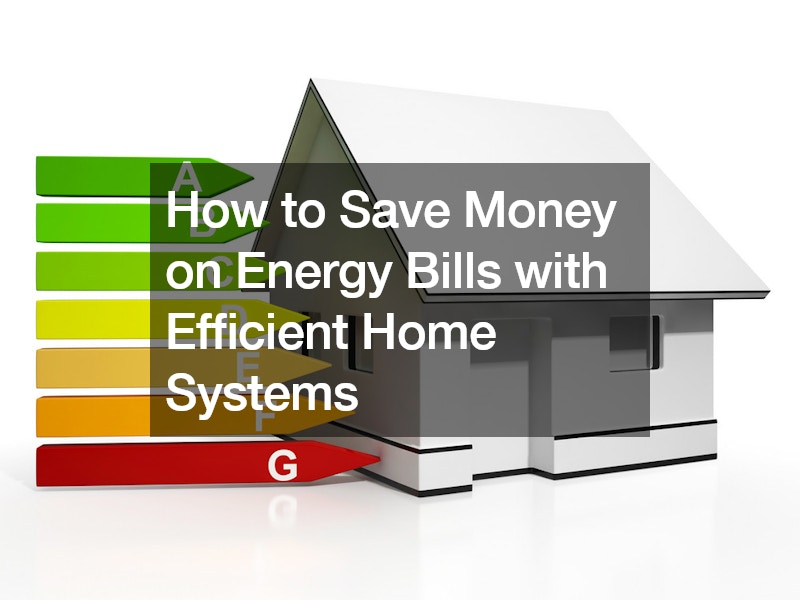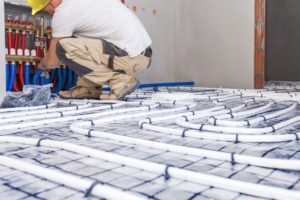In a world where environmental concerns and rising energy costs are at the forefront, ensuring your home is energy-efficient is not just a matter of comfort but also responsibility. From conducting thorough energy audits to implementing cutting-edge technologies, there are numerous steps homeowners can take to reduce their energy consumption and carbon footprint. In this guide, we’ll explore a variety of strategies and upgrades to transform your home into an energy-efficient haven.
1. Conducting an Energy Audit

Before thinking of any energy efficiency upgrades, it’s crucial to clearly understand your home’s current energy usage patterns and areas of inefficiency. This is where an energy audit comes into play. An energy audit is essentially a comprehensive assessment of your home’s energy consumption and efficiency conducted by trained professionals.
The Process of an Energy Audit
- Initial Assessment: The energy auditor begins by gathering information about your home, including its size, age, construction materials, and existing energy systems.
- On-Site Inspection: A comprehensive walk-through of your home is conducted, during which the auditor examines various components such as insulation, windows, doors, HVAC systems, and appliances. Electrical inspections are also performed to evaluate the condition and efficiency of your home’s electrical infrastructure.
- Diagnostic Testing: Advanced diagnostic tools may be used to assess air leakage, insulation levels, ductwork efficiency, and appliance energy consumption. These tests provide quantitative data to identify specific areas of improvement.
- Analysis and Recommendations: Based on the findings from the inspection and diagnostic testing, the auditor compiles a detailed report outlining energy-saving opportunities and recommendations for upgrades. This report typically includes cost estimates, potential energy savings, and payback periods for each proposed improvement.
2. Upgrading Insulation
One of the most effective ways to improve energy efficiency is by upgrading insulation. Proper insulation is an energy efficient solution that helps maintain consistent indoor temperatures, reducing the workload on heating and cooling systems. Whether it’s adding insulation to attics, walls, or floors, investing in high-quality insulation pays off in long-term energy savings.
Types of Insulation Materials
- Fiberglass: Fiberglass insulation is one of the most common and cost-effective options available. It consists of fine glass fibers and is available in batts, rolls, and loose-fill forms. Fiberglass insulation offers excellent thermal performance and is relatively easy to install, making it a popular choice for homeowners.
- Cellulose: Made from recycled paper fibers treated with fire-retardant chemicals, cellulose insulation is a sustainable option with excellent thermal properties. It is often blown into attics and wall cavities to fill gaps and voids effectively. Cellulose insulation is eco-friendly, non-toxic, and resistant to pests and mold.
- Spray Foam: Spray foam insulation is a high-performance option that forms an airtight seal when applied. It expands upon contact, filling gaps and cracks to prevent air leakage effectively. While more expensive than other insulation types, spray foam offers superior thermal resistance and energy savings.
- Rigid Foam: Rigid foam insulation panels are dense, lightweight boards made from polystyrene, polyisocyanurate, or polyurethane. They are typically used in applications where space is limited, such as under concrete slabs or on exterior walls. Rigid foam insulation offers excellent thermal resistance and moisture resistance.
3. Sealing Leaks and Cracks
Even a well-insulated home can lose energy through leaks and cracks in its structure. Sealing gaps around windows, doors, and utility penetrations prevents conditioned air from escaping and outside air from infiltrating your home. Simple measures like caulking, weatherstripping, and insulating foam can make a significant difference in energy efficiency, reducing heating and cooling costs while enhancing comfort.
Methods of Sealing Leaks and Cracks
- Caulking: Caulk is a versatile material commonly used to seal gaps and cracks around windows, doors, and trim. It forms a flexible seal that prevents air and moisture infiltration, helping to maintain airtightness and energy efficiency. Silicone and latex-based caulks are popular options for sealing exterior gaps, while acrylic caulks are suitable for interior applications.
- Weatherstripping: Weatherstripping is applied to the moving parts of windows and doors to create a tight seal when closed. It comes in various materials, including foam, rubber, and felt, and is available in adhesive-backed strips or rolls. Weatherstripping helps prevent air leaks and drafts, improving energy efficiency and comfort.
- Insulating Foam: Spray foam insulation is an effective solution for sealing larger gaps and cracks in walls, ceilings, and floors. It expands upon application, filling voids and creating an airtight seal that prevents air infiltration. Spray foam insulation is particularly useful in hard-to-reach areas and irregularly shaped spaces, providing superior insulation and energy savings.
- Door Sweeps and Thresholds: Installing door sweeps and thresholds at the bottom of exterior doors helps seal gaps between the door and the threshold, preventing drafts and energy loss. Door sweeps consist of a flexible strip of rubber or vinyl that seals the gap between the door bottom and the threshold, while thresholds create a tight seal along the bottom edge of the door.
4. Installing Energy-Efficient Windows

Installing energy-efficient windows is a pivotal step in enhancing a home’s energy performance and overall comfort. These windows not only improve insulation but also optimize natural light intake, creating a more sustainable and inviting living space. A window replacement company offers a wide range of energy-efficient options, including windows with low-emissivity (low-E) coatings and multiple panes filled with insulating gas. These features minimize heat transfer and air leakage, reducing the workload on heating and cooling systems and resulting in lower energy bills.
Proper installation is critical to reaping the full benefits of energy-efficient windows. A tight seal ensures optimal thermal performance and prevents air infiltration, maximizing energy savings and enhancing long-term durability. Homeowners should work with experienced professionals to ensure precise measurements, proper fit, and seamless integration with existing structures.
5. Choosing Energy-Efficient Appliances
Choosing energy-efficient appliances is a critical step in reducing household energy consumption and promoting sustainability. Given that home appliances account for a substantial portion of energy usage, prioritizing energy efficiency can lead to significant long-term savings and environmental benefits.
When shopping for new appliances, it’s essential to look for ENERGY STAR certification, which indicates that the appliance meets strict energy efficiency criteria set by the Environmental Protection Agency (EPA). ENERGY STAR appliances are designed to consume less energy while delivering the same or superior performance compared to standard models, making them an excellent choice for environmentally conscious consumers.
Collaborating with an experienced electrical contractor can further enhance the selection process by providing expert guidance and recommendations tailored to your specific needs and budget. Whether you’re in the market for a new refrigerator, washing machine, dishwasher, or other household appliances, consulting with an electrical contractor ensures that you make informed decisions that align with your energy-saving goals.
6. Using Smart Thermostats

Using smart thermostats revolutionizes how homeowners manage their HVAC systems, providing not just temperature control but also energy efficiency insights. These innovative devices go beyond traditional thermostats by learning household patterns and preferences, ultimately fine-tuning heating and cooling schedules for maximum efficiency and comfort. By analyzing occupancy patterns, weather forecasts, and user behavior, smart thermostats create personalized heating and cooling profiles tailored to each homeowner’s lifestyle.
Moreover, the remote access capabilities of smart thermostats add another layer of convenience and energy savings. Homeowners can monitor and adjust their HVAC settings from anywhere using smartphone apps or web interfaces, providing unprecedented control over energy usage even when away from home. Whether adjusting the temperature before returning from vacation or setting a schedule for a weekend getaway, remote access ensures optimal energy management and comfort while minimizing energy costs.
Additionally, smart thermostats often feature energy usage tracking and reporting tools, allowing homeowners to visualize their energy consumption patterns and identify areas for further optimization. Providing real-time insights and control, smart thermostats pave the way for a more efficient, comfortable, and sustainable home environment.
7. Installing LED Lighting
Lighting accounts for a significant portion of household electricity consumption, making it a prime target for energy efficiency upgrades. LED (Light Emitting Diode) lighting offers unparalleled energy savings compared to traditional incandescent and fluorescent bulbs. By partnering with reputable lighting suppliers, homeowners can access a wide range of LED fixtures and bulbs tailored to their needs. LED lighting not only reduces energy costs but also lasts longer and produces less heat, contributing to a cooler and more comfortable indoor environment.
8. Utilizing Solar Panels

Harnessing the power of the sun through solar panels is a sustainable way to generate electricity and reduce reliance on the grid. Working with a reputable solar panel company, homeowners can explore various solar options, from rooftop installations to ground-mounted arrays.
Apart from financial savings, solar panels offer a range of environmental benefits, including reduced carbon emissions, improved air quality, and conservation of natural resources. Furthermore, homeowners may be eligible for various incentives and rebates, such as federal tax credits and state-level incentives, which further enhance the financial attractiveness of solar energy adoption. Net metering programs allow homeowners to offset their electricity bills by selling excess solar energy back to the grid, providing additional savings and revenue opportunities.
Through solar installation, homeowners not only contribute to a cleaner, greener future but also enjoy greater energy independence, resilience, and financial stability in the long run.
9. Enhancing HVAC Systems
Heating, ventilation, and air conditioning (HVAC) systems are the backbone of home comfort and energy efficiency. They regulate indoor temperature, humidity levels, and air quality, making them essential components of any household. Enhancing HVAC systems involves a combination of regular maintenance, equipment upgrades, and advanced controls to optimize performance and energy savings.
- Regular Maintenance: HVAC system maintenance is crucial for ensuring the longevity and efficiency of HVAC systems. This includes cleaning or replacing air filters, inspecting ductwork for leaks, lubricating moving parts, and checking refrigerant levels. Regular maintenance not only improves system performance but also prevents costly breakdowns and extends the lifespan of HVAC equipment.
- Upgrading to High-Efficiency Equipment: Upgrading to high-efficiency HVAC equipment, such as ENERGY STAR-rated furnaces, boilers, and air conditioners, is a significant step towards reducing energy consumption and utility bills. These energy-efficient systems use advanced technologies, such as variable-speed motors and modulating compressors, to deliver precise heating and cooling while minimizing energy waste. Investing in high-efficiency HVAC equipment pays off in long-term energy savings and enhanced indoor comfort.
- Smart HVAC Controls: Smart HVAC controls, such as programmable thermostats and zoning systems, offer advanced features for optimizing energy usage and comfort. Programmable thermostats allow homeowners to create customized heating and cooling schedules based on their daily routines and occupancy patterns. Zoning systems divide the home into separate zones with individual temperature controls, allowing for precise temperature management and energy optimization in different areas of the house.
- Indoor Air Quality Solutions: In addition to temperature control, enhancing HVAC systems involves addressing indoor air quality (IAQ) issues. Installing air purifiers, humidifiers, and ventilation systems helps remove pollutants, regulate humidity levels, and promote healthier indoor air. Improved IAQ not only enhances comfort but also reduces respiratory issues and allergies, contributing to overall well-being.
10. Using Energy-Efficient Water Heaters
Water heating is a major contributor to household energy consumption, accounting for a significant portion of utility bills. Therefore, optimizing the efficiency of water heaters is crucial for reducing energy usage and utility costs. One effective solution is upgrading to energy-efficient water heaters, which offer improved performance and lower energy consumption compared to traditional models.
Types of Energy-Efficient Water Heaters
- Tankless Water Heaters: Tankless water heaters, also known as on-demand or instantaneous water heaters, heat water directly without the need for a storage tank. This eliminates standby energy losses associated with traditional tank-style heaters, resulting in higher energy efficiency and lower operating costs. Tankless water heater installation provides hot water on demand, ensuring endless hot water supply while reducing energy waste.
- Heat Pump Water Heaters: Heat pump water heaters extract heat from the surrounding air to heat water, making them significantly more energy-efficient than conventional electric water heaters. By leveraging ambient air temperature, heat pump water heaters can deliver hot water with minimal energy consumption, resulting in lower utility bills and reduced environmental impact. These systems are particularly effective in warm climates with moderate to high humidity levels.
- Solar Water Heating Systems: Solar water heating systems utilize solar collectors to absorb sunlight and heat water for domestic use. By harnessing the abundant and renewable energy of the sun, solar water heaters offer a sustainable and cost-effective alternative to conventional water heating methods. While upfront costs may be higher, solar water heating systems can provide substantial long-term savings on energy bills and reduce reliance on fossil fuels.
Partnering with experts in water heater system installation is essential for maximizing the energy efficiency and longevity of your system. Professionals can assess your household’s hot water needs, recommend the most suitable water heater type and size, and ensure proper installation and maintenance.
11. Installing Programmable Timers
Programmable timers and smart switches allow homeowners to automate lighting, heating, and cooling systems based on their schedule and occupancy patterns. By setting predetermined schedules and adjusting settings remotely, homeowners can minimize energy waste and optimize comfort. Whether it’s turning off lights in unoccupied rooms or adjusting thermostat settings during peak usage hours, programmable timers help reduce energy consumption without sacrificing convenience.
12. Using Power Strips
Electronics and appliances continue to draw power even when turned off, a phenomenon known as standby power or vampire power. Using power strips with built-in surge protection and on/off switches allows homeowners to easily disconnect multiple devices when not in use, eliminating standby power consumption. By consolidating power sources and controlling energy flow, power strips help reduce phantom loads and save energy, contributing to lower electricity bills and environmental conservation.
13. Integrated Home Security Systems
Integrating home security systems with energy management features offers a holistic approach to improving household efficiency and safety. Wireless security systems equipped with motion sensors and smart cameras provide real-time monitoring and alerts, enhancing home security while minimizing energy waste. By synchronizing security settings with lighting, heating, and cooling systems, homeowners can optimize energy usage based on occupancy and security needs.
Furthermore, remote access via smartphone apps allows for seamless control and monitoring, ensuring peace of mind and energy savings, even when away from home. Collaborating with reputable providers of integrated home security systems ensures seamless integration with existing infrastructure and personalized solutions tailored to your home’s needs.
Final Thoughts
Transforming your home into an energy-efficient sanctuary is both achievable and rewarding. By implementing a combination of upgrades, from insulation and windows to appliances and lighting, homeowners can significantly reduce energy consumption, lower utility bills, and contribute to a more sustainable future.
Whether through simple behavioral changes or advanced technology integration, every step towards energy efficiency brings us closer to a greener, more resilient world for generations to come.




